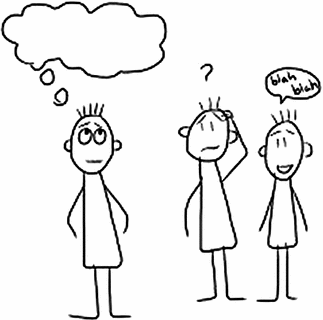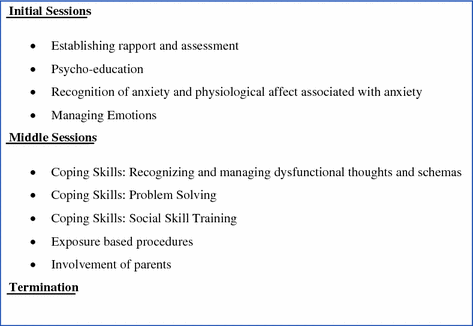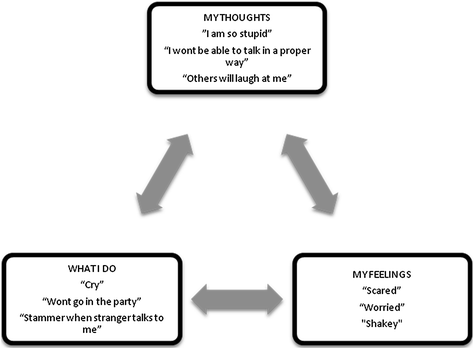Fig. 10.1
Cognitive model of development of anxiety (Rapee 2001). Reproduced with permission from author
According to the model, genetic, shared as well as non-shared environmental factors play an important role in the development of anxiety. Some individuals are born with a genetic vulnerability to develop anxiety, which is manifested through their temperament and is evident in high level of arousal, emotionality, and a coping style characterized by avoidance. The temperament is the guiding force behind choosing an environment that maintains their coping style and also elicits protective behavior from significant others’ (i.e., parents). In turn, this “over-protectiveness” may exaggerate the individual’s threat perception leading to development of symptoms of anxiety disorders.
10.1.1 Presentation of Anxiety Symptoms
As mentioned earlier, anxiety is not always pathological; however, it is commonly accepted across cultures that it becomes maladaptive when it is persistent, severe, and frequent, gives rise to avoidance behaviors and interferes with functioning. In children and adolescents, the differentiation between normal and pathological anxiety is a particularly difficult task, as they tend to manifest many anxiety-like symptoms as a part of normal development.
Table 10.1 illustrates some of the normative anxiety in childhood and adolescence along with the corresponding anxiety disorders that the adolescent may develop (Beesdo et al. 2009; Muris et al. 1998).
Table 10.1
Normative and pathological anxiety in childhood and adolescence
Age | Development conditioned period of fear and anxiety | Psychopathological relevant symptoms |
|---|---|---|
Toddler (12–18 months) | Separation anxiety | Sleep disturbances, nocturnal panic attacks, oppositional behavior |
Toddler (2–3 years) | Fear of thunder, lightening, fire, animals, darkness, etc. | Crying, clinging, withdrawal, freezing, avoidance, secondary enuresis |
Early childhood (4–5 years) | Fear of death or dead people | |
Primary school (5–7 years) | Fear of specific objects, fear of germs, fear of natural disasters/accidents, school anxiety | Withdrawal, timidity, extreme shyness to unfamiliar people, feelings of shame, avoidance |
Adolescence (12–18 years) | Rejection from peers | Fear of negative evaluation, difficulty in forming interpersonal relationships |
Most commonly seen anxiety symptoms in adolescents, which can be highly debilitating are manifested in form of social anxiety and examination anxiety. Social anxiety can be typically seen in form of having less friends, difficulty in classroom activities participation, and avoidance of social interaction (e.g., initiating conversations). It is further associated with loneliness, dysphoria, and long-term functional impairment. Examination anxiety is seen in form of moderate to severe anxiety before tests/exams or in any situation where the adolescent would be evaluated. This can lead to decreased performance and poor self-esteem. Thus, it is important for the clinician to carefully assess for the presence of these syndromes and plan management accordingly.
10.1.2 Comorbidity and Dysfunction
Usually presentation of anxiety symptoms in adolescence is complex and chronic. By late adolescence or early adulthood, decrease is seen in cases meeting the criteria for one anxiety disorder in favor of development of multiple anxiety disorders (Ollendick et al. 2008). It seems that the “load” of anxiety tends to contribute to the development of secondary complications. It has been consistently shown that anxious children are 8–29 times at risk of developing additional depression (Ford et al. 2003). Besides depression, alcohol and substance use and externalizing disorders, such as ADHD and conduct disorders are the most commonly co-occurring disorders (Bittner et al. 2007; Kendall et al. 2004; Ollendick et al. 2008).
Given these findings, it is important to work on the adolescent’s coping skills and family’s behavior early on to facilitate healthy development and possibly halt the transition to full-blown anxiety disorders. Thus, this chapter would highlight the role of cognitive behavior therapy or CBT with adolescents with anxiety symptoms as well as the need for involving their parents in the treatment process.
10.1.3 Cognitive Behavior Therapy
Various cognitive as well as behavioral factors are implicated in the development and maintenance of anxiety symptoms in adolescents. Therefore, it goes without saying that changes in approach/avoidance behaviors and cognitions are considered to be crucial for treatment change (Rapee et al. 2000), and therefore, CBT appears to be the obvious choice for management of anxiety symptoms.
The primary goals of CBT in adolescents with anxiety symptoms are to change the maladaptive learnings and thought patterns. It also involves skill-building in the session (use of role-plays and games, etc.) with an emphasis on generalizing these skills outside the sessions. As part of skill-building segments or as homework assignment, the adolescent is encouraged to practice the learnt skills in actual anxiety-provoking situations. The rationale behind exposure is that it helps the teenager in developing a sense of self-competence, which he/she also learns to acknowledge and appreciate. Additionally, an important component is involvement of parents or significant others who are not only made more sensitive to adolescent’s condition, but also learn newer skills to reinforce positive coping behaviors (Rapee et al. 2009).
To facilitate the process of learning and skill-building, the therapist needs to play the role of a “collaborative coach” who generates treatment goals with the adolescent and his/her family and tailors the intervention to match the person’s interest and ability. It has been seen that in most cases, 12–16 weeks of active treatment sessions are required, followed by spaced out “booster sessions” (Seligman and Ollendick 2011).
10.2 Assessment
Given the fact the anxiety can present as a normative developmental behavior in adolescents, its assessment and differentiating between normal, subclinical and pathological anxiety states becomes challenging as well as important.
Therefore, a thorough assessment is of utmost importance before embarking on the course of successful cognitive behavior therapy. The first and foremost step in assessment is a complete diagnostic evaluation, and efforts should be made to determine whether the presenting symptoms are clinically significant. Given the high rate of comorbidity, precautions should be taken to determine their presence and deciding which symptoms would form the primary target for interventions. Avoidance patterns, environment’s reaction (for example, parents) to avoidance behaviors, and cognitive patterns of appraisals should be elicited in details so as to develop an individual case formulation. Information should be sought from as many sources as possible to have a full understanding of the person’s symptoms and their context.
Assessment includes both interviews and rating scales. However, behavioral and cognitive assessment forms a crucial element in reaching an individualized formulation and tailoring of treatment to meet the needs, age, and ability of the individuals. See Appendix I for more details on assessment.
10.2.1 Interviews
The interview remains one of the most common methods for assessing anxiety symptoms in adolescents. Interviews can be structured or semi-structured, or they can be completely unstructured to elicit chief complaints, history of symptoms, temperament issues, ways of coping, and relationship patterns with significant others. A well-conducted interview should be able to provide glimpses into behavioral avoidance of fearful situations and the reinforcing factors for the same.
Apart from the adolescent, the family members should be interviewed as it would be useful in eliciting more information about adolescent’s anxiety symptoms as well as to assess the concerns, coping strategies, and behaviors of the family members. It is often useful to interview the adolescent first and then talking to the family member as it can help the therapist becoming an ally of the adolescent.
10.2.2 Rating Scales
There are many rating scales that have been used for assessment of anxiety and anxiety disorders in children and adolescents. Moreover, administration of rating scales pre- and post-intervention can provide valuable information about changes in intensity of the symptoms. Although these tools have been developed in the Western countries and most of them have not been standardized for the Indian setting, they can be used to gain valuable information about the adolescent and his/her anxiety symptoms.
10.2.3 Cognitive and Behavioral Assessment
The rating scales and diagnostic schedules help the therapist to assess the presence or intensity of anxiety symptoms. However, to make a cognitive behavior formulation and subsequently plan CBT, the clinician needs to access the teen’s thoughts, behaviors, and feelings in various situations and also his/her current repertoire of coping skills and abilities. The techniques for eliciting cognitions, emotions, and behavior patterns of the adolescent are as follows:
Direct questioning
Indirect assessment of anxiety
Behavior analysis
Direct questioning: Once rapport has been established adequately, the therapist can engage the adolescent in direct questioning. Open-ended questions should be used to allow the adolescent to articulate freely. Some of the direct questions can be as follows:
“What are you thinking?”
“What thought came to your mind when you first met me?”
“What are the thoughts that run through your mind when you see a snake (or any particular animal the adolescent is afraid of)?”
“What thoughts came to your mind when your friends asked you to talk to that girl/boy you really like?”
“What are your thoughts when you are not able to wash your hands as often as possible?”
“How did you feel when you were left alone with a group of strangers in that party?”
“How do you feel when you get up in the morning?”
Assessing anxiety indirectly: If the rapport is well-established, most adolescent would be able to provide information with direct questioning. However, sometimes a reluctant, introvert, or unsure adolescent may answer with, “I don’t know” or “I m not sure.” With these kinds of individuals, eliciting information through other means might work better; for example, they may be more comfortable in telling what someone else might be thinking in the similar situation. This can be done with the use of series of stories or thought bubbles. The adolescent can be presented with a vignette and asked to describe what the characters were thinking and feeling (Fig. 10.2).


Fig. 10.2
An anxious adolescent in a social situation
Behavior analysis: With slightly older children and adolescent, the therapist can make use of behavioral charts that can easily identify the thoughts, feelings, and behaviors of the person. This should be given as homework assignment that should be filled each time the individual feels anxious. An example of behavioral chart is given in Table 10.2.
Table 10.2
Example of Behavior chart
Day/Time | Situation | Thoughts | Emotions | Behavior |
|---|---|---|---|---|
What were you doing? Whom were you with? What exactly happened? | What were you thinking? Rate how much you believe them on a scale of 0–10 | How did you feel? Rate your feelings on a scale of 0–10 | What did you do? What happened after that? |
10.3 Case Vignettes
Case Vignette 1: Juhi, a 16-year-old girl studying in class IX was bought for therapy by her parents. The main complaints were difficulty in talking to new people, feeling insecure, and feeling anxious in social situation. She had been experiencing these symptoms since a long time, but these had worsened in the past few months. Rapport was established, and diagnostic schedules were administered. Though she did not meet full criteria for social anxiety disorder, she was highly distressed by her symptoms. It was also seen that the primary caregiver who was the mother also exhibited anxiety symptoms during traveling alone in public transport, at high places and while undertaking long journeys. She would also be extra worried if Juhi was even 20–30 min late while coming from school or party.
10.4 Intervention
Skill-based CBT packages for management of anxiety symptoms in adolescents typically include psycho-education, affect recognition, cognitive restructuring, relaxation, and exposure. Additional areas may include assertiveness, social skill training, and problem-solving strategies. Most of these packages also include a parent component (Kendall and Hedtke 2006). Figure 10.3 delineates the various techniques to be used while intervening with anxious adolescents.


Fig. 10.3
Session-wise CBT techniques
10.4.1 Establishing Rapport and Conducting Assessment
Some fundamental aspects of engagement in CBT are the motivation to change, capacity to learn, and use the skills. Developmental and social aspects tend to influence the adolescent’s motivation to engage in therapy (Holmbeck et al. 2006). Some of these factors can be-being “bought” for treatment, fear of giving up established patterns of behaving, adolescent “egocentrism,” reduced capacity for self-reflection, and need for autonomy and therefore conflict with adult figures (Stallard 2009).
A good rapport is the foundation stone of therapy. Thus, the first and most important step is establishing a rapport with the adolescent. Apart from assessing anxiety symptoms, the first couple of sessions should be dedicated to developing a good working alliance with the adolescent. Some of the ways of establishing rapport and boosting motivation can be as follows (Sauter et al. 2009):
(a)
Engaging first with the adolescent and then family members
(b)
Providing psycho-education to match the adolescent’s cognitive level of understanding
(c)
Providing facts and correct information while maintaining genuine interest in adolescent’s welfare
(d)
Boosting the adolescent’s confidence in their ability to change
(e)
Avoiding questioning and confrontations
(f)
Orienting the adolescent to their personal goals
(g)
Working collaboratively with the young person to set goals and have a say in the pace of treatment
(h)
Encouraging adolescent to offer inputs for agenda of each session
Once rapport has been established, the therapist can conduct assessment of anxiety symptoms and comorbid conditions as discussed in the previous section. Although assessment is a continuous process, new information can arise at any point of time. However, an initial thorough assessment usually takes about 1–3 sessions after which interventions can be initiated.
10.4.2 Providing Psycho-Education
Psycho-education forms an important part of CBT as it provides the adolescent as well as the family with a wider perspective into what is happening, and it also helps them to prepare themselves for the treatment sessions. In the above-mentioned case (case vignette 1), the following components of psycho-education were incorporated (also see Fig. 10.4):


Fig. 10.4
Explanation for how thoughts, feelings, and behavior are related
She was made to understand nature of anxiety, the fact that is a common and natural response encompassing certain physiological reactions that are accompanied by negative thoughts, feeling anxious, and avoidance behaviors. The therapist then emphasized that some anxiety is helpful, but at times, it blows out of proportion, which can cause problems in daily living.
She was made to understand the basic premises behind cognitive behavior therapy, course of treatment, and how goals would be set.
Stay updated, free articles. Join our Telegram channel

Full access? Get Clinical Tree






